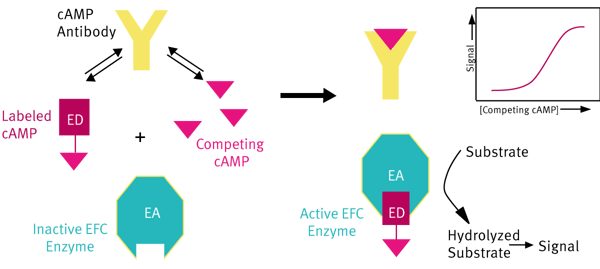Introduction
G-protein coupled receptors (GPCRs) are cell surface receptors, which represent the most predominant drug targets. Following stimulation of these receptors, intra-cellular signalling pathways are activated and this leads to a decrease (coupling to a Gi protein) or increase (via Gs or Gq proteins) in the production of intracellular second messengers. The common way of determining the activity of compounds is by measuring the cellular formation of second messengers such as cAMP and calcium.
The HitHunter® cAMP High Sensitivity (HS) assay is able to measure low cAMP levels and is, therefore, particularly suitable for cell-lines that endogenously express receptors at a level much lower than in transfected cells overexpressing a cloned GPCR.
HitHunter® cAMP assays are in vitro-based competitive immunoassays that rely on enzyme fragment complementation technology (EFC, Fig. 1).
Free cAMP molecules from cell lysates compete for antibody binding with a labelled enzyme donor (ED)-cAMP conjugate, which contains a small peptide fragment of ß-galactosidase. In the absence of free cAMP, the ED-cAMP conjugates are captured by the cAMP-specific antibody and are unavailable for complementation with the enzyme acceptor (EA), resulting in a low signal. In the presence of free cAMP, antibody sites are occupied, allowing the ED-cAMP conjugate to complement with EA, forming an active ß-galactosidase enzyme; substrate hydrolysis by this enzyme produces a chemiluminescent signal. The signal generated is in direct proportion to the amount of free cAMP bound by the antibody. Any luminescence reader used with the HitHunter® cAMP HS assay has to be sensitive enough to detect small changes in cAMP levels. BMG LABTECH microplate readers have this required sensitivity.
The purpose of this Application Note is to detect changes in cAMP levels following agonist stimulation of cells in the absence and presence of receptor antagonists. In this study, we used the rat PC12 phaeochromocytoma cell-line which endogenously expresses adenosine A2A and A2B receptors. Here, we have utilised compounds selective for the A2A receptor.
Materials & Methods
HitHunter® cAMP HS kit reagents (DiscoverX):
- Lysis buffer and antibody mixture
- ED reagent
- EA reagent and CL substrate mixture
- cAMP standard (0.25mM)
Other reagents and materials:
- Rat PC12 phaeochromocytoma cell-line (ATCC)
- Dulbecco’s Phosphate Buffered Saline (PBS; Cambrex)
- Microplate, low volume, white with clear bottom, tissue culture treated, sterile, 96-well (Corning)
- Agonist (CGS21680; Tocris)
- Antagonist (ZM241385; Tocris)
- IBMX (Sigma; optional)
A full description of the use of the HitHunter® cAMP assay is included with the kit. Low volume 96-well microplates were used.
To produce the standard curve, the cAMP standard provided in the kit was diluted 1 in 25 to prepare the highest working concentration, which was then used to prepare 1 in 3 serial dilutions in PBS giving a range of concentrations from 2.7 × 10-6M to 4.6 × 10-11M cAMP in a final assay volume of 55 μL. PBS alone was used as the control. PBS was also used, with PC12 cells, to measure the cAMP produced by constitutive receptor activity (basal activity).
Assay protocol (low volume 96-well plate):
PC12 cells were seeded 48 hours prior to the experiment at a density of 20,000 cells per well.
-
Add cAMP standard dilutions (15 μL) to empty wells
-
Remove media from the cells and resuspend them in PBS containing 500μM IBMX (10 μL)
-
Add antagonist to the cells (5 μL)
-
Incubate at 37°C for 15 min
-
Add agonist to the cells (5 μL)
-
Incubate at 37°C for 30 min
-
Add 10 μL of Lysis buffer and antibody mixture to each well
-
Incubate at room temperature for 60 min
-
Add 10 μL of ED reagent to each well
-
Incubate at room temperature for 60 min
-
Add 20 μL of EA reagent and CL substrate mixture to each well
-
Incubate at room temperature for at least 60 min
Chemiluminescence is then read on the BMG LABTECH microplate reader 4 hours after the addition of the last reagent.
BMG LABTECH microplate reader settings:
Basic parameters for luminescence plate mode detection are listed below:
| Read mode: | Plate |
| Positioning delay: | 0.2 sec |
| No. of kinetic windows: | 1 |
| No. of multichromatics | 1 |
| Emission filter: | Lens |
| Gain: | 3300-3600 (depending on reader) |
| Measurement interval time: | 1 sec |
Results & Discussion
The HitHunter® cAMP HS assay from DiscoverX was used in 96-well format, and data from standard and agonist curves were obtained from the BMG LABTECH microplate reader in luminescence mode. Reagents were added according to the manufacturer’s protocol, and chemiluminescence was read 4 hours after the addition of the last reagent. Data were evaluated using the MARS data analysis software and the software package GraphPad Prism.
 Fig. 2 illustrates the cAMP standard curve obtained using luminescence detection in a 96-well format. The curve shows a dose-dependent increase with a good signal-to-background noise (S/B) value of 11. Dose-response curves for the selective A2A receptor agonist CGS21680 either alone or in the presence of the A2A receptor selective antagonist ZM241385 were generated (Fig. 3).
Fig. 2 illustrates the cAMP standard curve obtained using luminescence detection in a 96-well format. The curve shows a dose-dependent increase with a good signal-to-background noise (S/B) value of 11. Dose-response curves for the selective A2A receptor agonist CGS21680 either alone or in the presence of the A2A receptor selective antagonist ZM241385 were generated (Fig. 3).
A rightward shift of the agonist dose-response curve, and a decrease in the maximal response, was observed in the presence of 10-7M ZM241385. This shows that ZM241385 non-competitively antagonised (by 4-to 5-fold) the agonist-induced increase in intracellular cAMP levels.
Conclusion
The HitHunter® cAMP HS assay is particularly suitable for detecting small changes in cAMP levels such as those seen in the rat PC12 phaeochromocytoma cellline. Both agonist and antagonist data can be generated in conjunction with the BMG LABTECH microplate reader.



